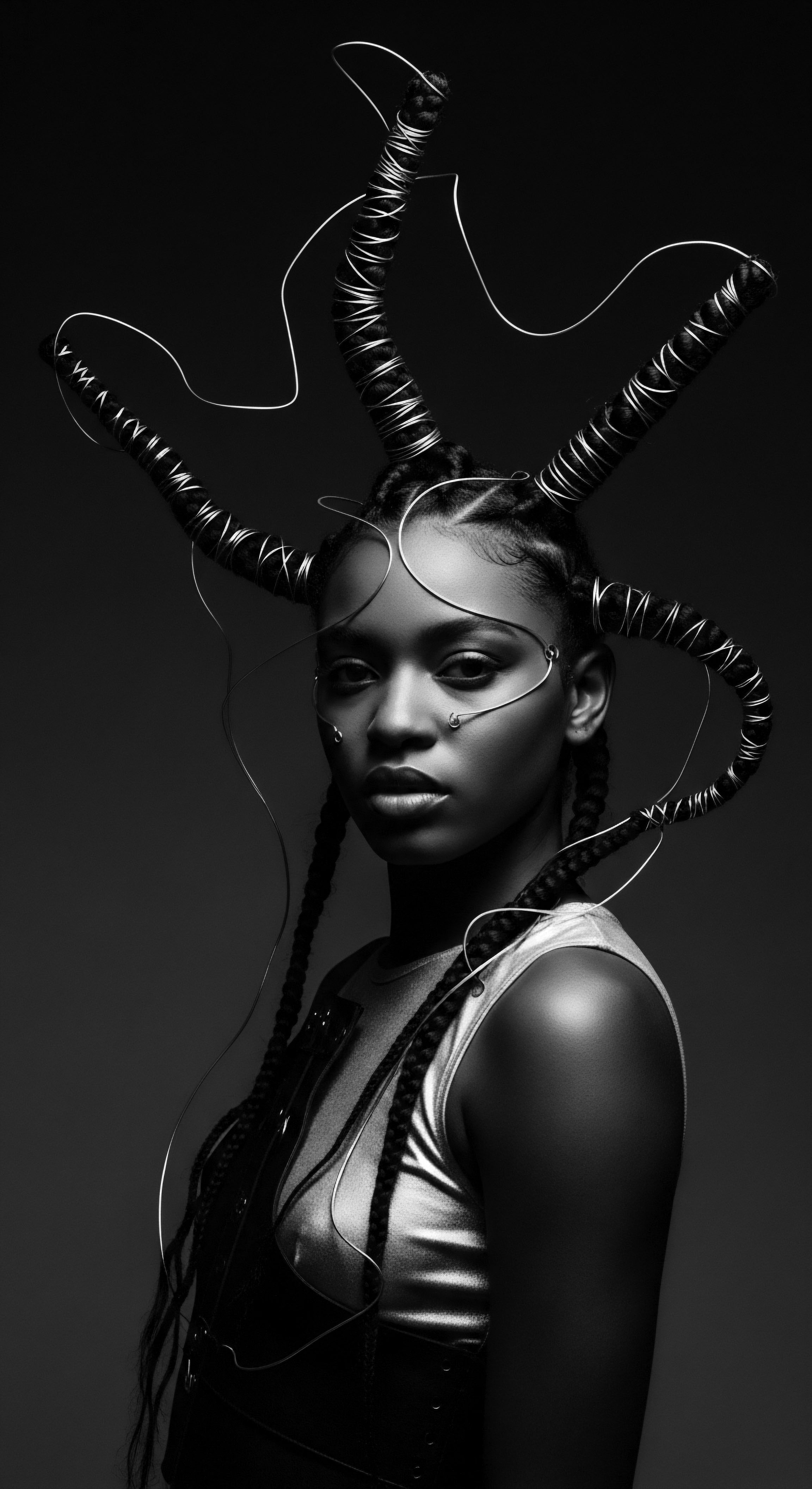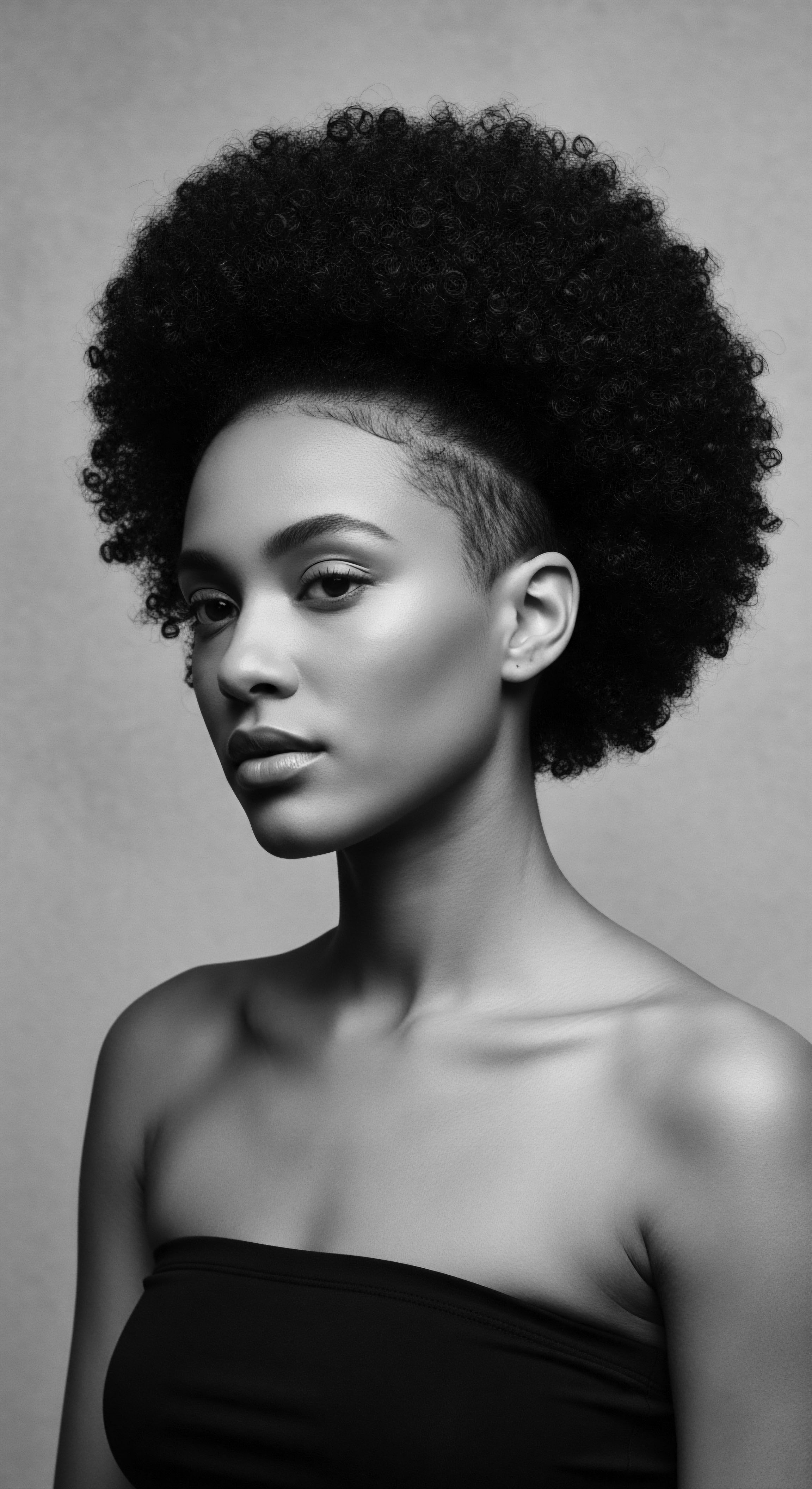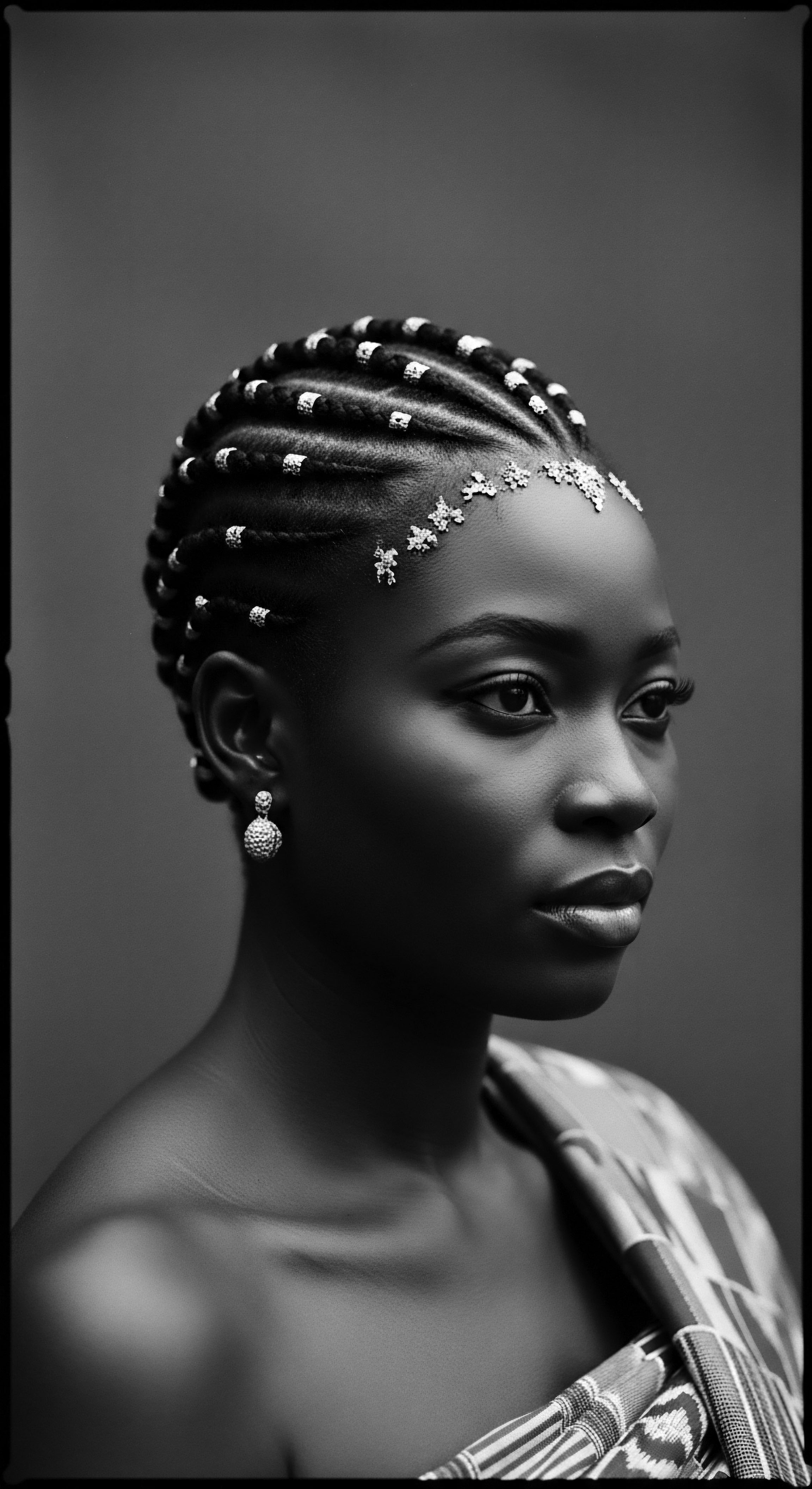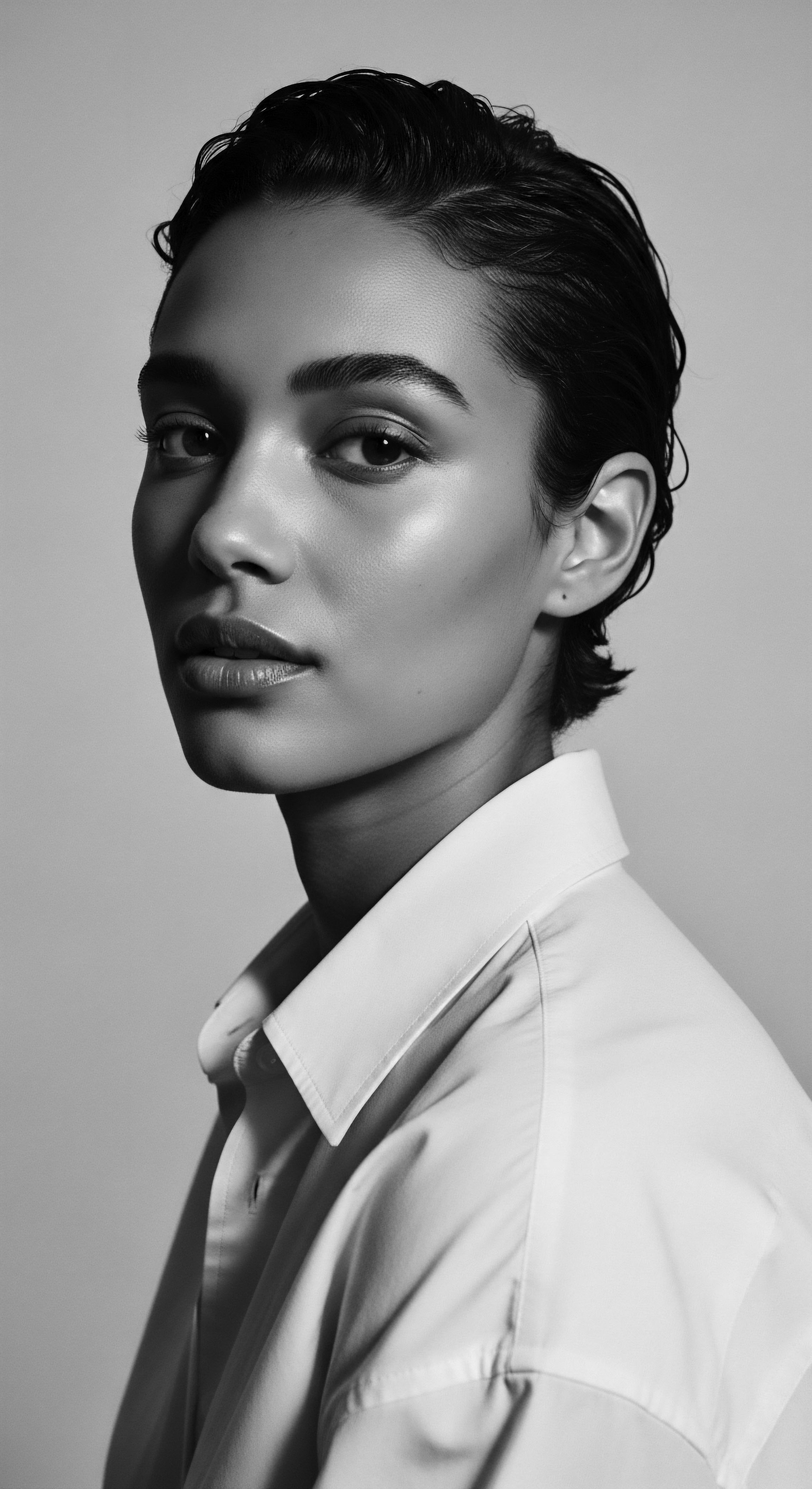
Roots
To truly understand how textured hair heritage informs modern elasticity remedies, one must first listen to the whispers of history, to the ancient echoes that reside within each curl, coil, and wave. Our hair, particularly that of Black and mixed-race people, is far more than a biological construct; it is a living archive, a scroll of ancestral wisdom, and a testament to resilience passed down through generations. For centuries, across diverse African civilizations and throughout the diaspora, hair practices were not merely about adornment. They were deeply spiritual, social, and political acts, intimately woven into the very fabric of identity and community.
The concept of hair elasticity, though not labeled with clinical precision in antiquity, was inherently understood through observation and practice. It was known as the hair’s very life force, its ability to bend without breaking, to retain its shape, to thrive in challenging environments.
Consider the nuanced structure of textured hair. Its elliptical or curved shaft shape gives rise to tightly coiled strands, creating points of vulnerability that can compromise tensile strength. This inherent fragility means that moisture retention is a primary concern, as dryness significantly increases breakage. Ancestors, through keen observation and iterative practice, discerned these vulnerabilities long before microscopes revealed the cellular intricacies.
Their remedies were not random concoctions but informed responses to the hair’s deep needs, aimed at preserving its inherent strength and flexibility. The rich history of hair in African cultures acted as a mirror to societal structures, personal identity, and spiritual beliefs.

Hair Anatomy and Ancestral Knowing
The very architecture of textured hair, with its unique bends and twists, predisposes it to dryness and, consequently, reduced flexibility. Moisture, therefore, has always been the cornerstone of hair care across African traditions. The Basara Arab Women of Chad, for instance, are celebrated for their exceptionally long, thick hair, often extending past the waist. Their secret, Chebe powder, functions not by directly accelerating growth from the scalp, but by fortifying the hair shaft, minimizing split ends, and notably, enhancing elasticity.
This ancient practice speaks volumes about an intuitive grasp of hair mechanics, where breakage prevention through conditioning was paramount for length retention. It suggests an early, profound understanding of what modern science now defines as elasticity – the hair’s capacity to stretch under tension and return to its original form.
The hair of Black and mixed-race people holds a living history, its inherent elasticity a direct link to ancestral practices centered on deep hydration and resilience.

How Does Hair Architecture Shape Its Needs?
Understanding the fundamental building blocks of textured hair helps us appreciate why ancient solutions persist. Each strand comprises a cuticle, cortex, and medulla. The cuticle, the outermost protective layer, tends to lift more easily in highly coiled hair, allowing moisture to escape. The cortex, where protein bonds reside, is responsible for the hair’s strength and elasticity.
Traditional practices, such as the regular application of oils and butters, aimed to seal this cuticle, thereby locking moisture within the cortex and maintaining the hair’s pliability. This protective approach was not just cosmetic; it was a deeply practical response to environmental factors and daily manipulation that could otherwise compromise the hair’s integrity.
The historical practices also recognized the interplay of internal and external factors. While topical applications were vital, the collective wisdom understood that well-being from within manifested outwardly. Though not framed in terms of “vascular endothelial growth factor” or “telogen to anagen phase transition” as modern studies might, the traditional holistic view of health, encompassing diet and community, certainly contributed to hair vitality.

The Lexicon of Hair and Heritage
The language used to describe textured hair and its care was, and remains, rich with cultural meaning. Terms for hair types, styles, and ingredients carried specific cultural weight, often indicating social status, marital standing, or tribal affiliation. While there was no direct ancestral term for “elasticity,” the properties associated with pliable, strong, and healthy hair were highly valued.
Consider the importance of Moisture in ancestral hair care, a direct antecedent to modern elasticity remedies. Ancient African traditions prioritized maintaining hydrated strands, viewing well-moisturized hair as healthy and vibrant. This was often achieved through the consistent use of natural butters and oils.
For instance, the use of hot oil treatments was recommended twice a month to boost both hair moisture and elasticity. This practice demonstrates a deep, intuitive understanding of how hydration contributes to the hair’s ability to stretch without breaking, a key characteristic of elasticity.
Specific terms, even if not directly translating to “elasticity,” denote its perceived qualities:
- Softness ❉ Often achieved through emollient-rich ingredients, indicating pliable strands.
- Suppleness ❉ Describing hair that moves freely and without stiffness, pointing to good flexibility.
- Resilience ❉ The ability of hair to withstand manipulation and environmental challenges, a hallmark of strong elasticity.
| Traditional Ingredient Shea Butter (Vitellaria paradoxa) |
| Ancestral Use Deeply moisturizing, protective barrier, wound healing. |
| Modern Scientific Link to Elasticity Rich in fatty acids and vitamins A and E, it seals the cuticle, reducing moisture loss and improving flexibility. |
| Traditional Ingredient Coconut Oil |
| Ancestral Use Deep conditioning, scalp healing, dandruff control. |
| Modern Scientific Link to Elasticity Penetrates the hair cortex to reduce protein loss, thereby enhancing strength and flexibility. |
| Traditional Ingredient Marula Oil |
| Ancestral Use Skin moisturizer, healing scars, rich in antioxidants. |
| Modern Scientific Link to Elasticity High in oleic acid and antioxidants, providing deep hydration and improving hair bounciness. |
| Traditional Ingredient Baobab Oil |
| Ancestral Use Nourishing, anti-inflammatory, promotes healthy skin. |
| Modern Scientific Link to Elasticity Packed with vitamins A, D, E, and omega fatty acids, it strengthens hair by penetrating the cortex and aids in texture and elasticity. |
| Traditional Ingredient These ancestral ingredients, utilized for generations, provide foundational insights into enhancing hair elasticity through natural, time-tested methods. |

Ritual
The rhythmic motions of braiding, the communal gathering for hair adornment, and the deliberate application of natural concoctions were more than routine; they were sacred rituals. These practices, steeped in generational wisdom, instinctively promoted hair elasticity, safeguarding textured strands from breakage and environmental stressors. The artistry in African hairstyles served as expressions of power, spirituality, and social cohesion. Hair care was a tender act, a dialogue between the hands and the strands, echoing ancient knowledge.
The protective styling choices, a cornerstone of traditional Black hair care, inherently aimed to preserve the hair’s integrity, which directly correlates to its elasticity. By minimizing daily manipulation and exposure, these styles allowed the hair to retain its natural moisture and strength. This approach stands in stark contrast to practices that prioritize temporary alterations at the expense of the hair’s long-term health.

Protective Styling and Ancestral Roots
Protective styles, such as Box Braids, twists, locs, and Bantu knots, have been present in African cultures for thousands of years. Their enduring popularity rests on a simple, profound principle ❉ keeping the ends of the hair tucked away reduces friction, tangling, and overall breakage. This method effectively preserves the hair’s natural moisture, a vital element in maintaining its stretch and recoil capabilities.
The less the hair is exposed to environmental elements or constant handling, the more it retains its inherent flexibility. These styles are designed to protect hair from damage caused by manipulation, environmental exposure, and styling practices.
For instance, the use of Cornrows, often called “canerows” in the Caribbean, was not just a symbol of ethnic identity; it was a highly practical way to manage hair, protect it, and allow it to retain moisture. The act of braiding itself, if done with gentle hands and proper tension, can seal the cuticle, aiding in moisture retention, which in turn supports elasticity. This long-held tradition showcases an intuitive understanding of hair health that modern science now validates.

What Ancient Styling Methods Protected Hair Health?
Beyond braids, ancestral methods included hair threading, where fibers or thread were wrapped around sections of hair, offering a gentle stretching and protective effect. This reduced tangling and breakage, promoting length retention and preserving the hair’s natural spring. The objective was never to permanently alter the hair’s inherent structure, but to work with it, to enhance its natural attributes, including its flexibility and strength.
The Basara women of Chad, for example, apply Chebe powder mixed with oils to damp, sectioned hair, which is then braided and left for days. This traditional application method directly contributes to length retention by preventing breakage and locking in moisture, strengthening the hair shaft and improving its elasticity. This ritualistic approach underscores how heritage practices directly contributed to elasticity, even without the formal scientific term.

Traditional Tools and Their Gentle Touch
The tools employed in ancestral hair care were crafted with the hair’s delicate nature in mind. Wide-toothed combs, often made from wood or bone, prevented ripping and tearing, contrasting sharply with the fine-toothed instruments favored in other cultures. Detangling was a slow, deliberate process, often performed on damp, well-oiled hair, section by section.
This careful approach minimized stress on the hair shaft, preserving the protein bonds that contribute to elasticity. Using a 100% natural, wide-toothed comb is recommended to avoid pulling and breaking strands.
The collective grooming sessions, often intergenerational, served as informal educational environments where techniques for gentle handling were passed down. These were not just social gatherings; they were practical workshops where the physical health of the hair, including its ability to stretch and rebound, was implicitly nurtured.
- Wide-Toothed Combs ❉ Used for gentle detangling, preventing excessive pulling and breakage.
- Natural Fibers ❉ Employed for protective threading and wrapping, reducing manipulation.
- Gourds and Clay Pots ❉ Vessels for mixing and storing natural concoctions, maintaining their potency.
The transition from chemical relaxers to natural hair, seen in the recent “natural hair movement,” brought a resurgence of interest in these traditional methods. Between 2012 and 2017, sales of hair relaxers dropped by 38 percent, a clear indication of a shifting paradigm back towards honoring natural texture and, by extension, its inherent elasticity. This modern return to ancestral wisdom reflects a collective re-discovery of what was always known ❉ hair thrives when treated with respect for its natural state.

Relay
The echoes of ancestral wisdom reverberate through contemporary discussions of hair elasticity, demonstrating a powerful continuum from ancient practices to modern scientific understanding. The legacy of textured hair care, deeply steeped in Black and mixed-race heritage, offers not just historical anecdotes but tangible, actionable insights for today’s remedies. It underscores that the quest for resilient, flexible strands is not new; it is a timeless pursuit, continually informed by the deep knowledge passed down through generations. The value of traditional methods lies in their inherent understanding of environmental factors and their impact on hair’s fundamental needs.

Holistic Care from Ancestral Wisdom
Ancestral communities understood hair health as an inseparable component of overall well-being. This holistic approach, wherein diet, spiritual practice, and physical care coalesced, laid the groundwork for modern concepts of hair vitality. For example, some African communities used Ghee Butter for hair care, a practice rooted in their wider wellness traditions. This speaks to a deeper connection between what was consumed or externally applied and its potential impact on hair strength and flexibility.
The traditional use of plant-derived oils for centuries served as a primary treatment for hair care, their popularity reclaiming prominence in recent years. These oils, rich in fatty acids and antioxidants, inherently address the specific needs of highly coiled hair, which is prone to dryness and breakage. The consistent application of these natural emollients helps to reduce friction, lubricate the strands, and seal in moisture, all contributing to improved hair elasticity.

How Do Ancient Ingredients Influence Modern Hair Science?
Modern science has begun to validate the efficacy of many traditional ingredients. Consider Rooibos Tea, traditionally grown in South Africa. Scientific studies have shown it contains antioxidants and antimicrobial effects, potentially boosting hair growth and improving hair strand quality. While its direct impact on elasticity may require further specific study, the general improvement in hair quality and health would naturally contribute to its flexibility.
Similarly, Rhassoul Clay, sourced from the Atlas Mountains of Morocco, has been used as a cleanser and conditioner. Its remineralizing and moisturizing properties aid in detangling, reducing dryness, and improving hair bounciness. These properties directly support elasticity by ensuring the hair is supple and less prone to breakage.
The historical emphasis on ingredients that moisturize and strengthen directly translates to contemporary elasticity remedies. Coconut oil, for instance, known ancestrally for its deep conditioning properties, has been scientifically shown to reduce protein loss in hair, making it a powerful choice for modern hair masks aiming for improved strength and flexibility. This alignment between ancient wisdom and scientific discovery is a powerful testament to the enduring relevance of heritage practices.

The Nighttime Sanctuary and Its Legacy
The careful protection of hair during sleep, particularly through the use of head coverings, is a practice deeply ingrained in many African and diasporic cultures. This seemingly simple ritual is a sophisticated strategy for preserving hair elasticity. Covering hair with materials like satin or silk reduces friction against absorbent bedding, thereby preventing moisture loss and minimizing tangles and breakage.
Nighttime rituals of hair protection are a legacy of ancestral wisdom, preserving moisture and elasticity for coiled strands.
While bonnets as we know them today are more recent iterations, the concept of covering hair for preservation is ancient. Historically, women might have used cloths, wraps, or even carefully constructed hairstyles to protect their hair overnight. This practice stems from an inherent understanding of how constant friction and environmental exposure can compromise the hair’s delicate structure, leading to dryness and reduced elasticity. By creating a protective barrier, these practices ensured the hair retained its natural oils and moisture, crucial for maintaining pliability.

What Does Modern Research Say About Hair Protection?
Modern dermatology and hair science echo these ancestral practices, recommending sleep protection as a key component of a healthy textured hair regimen. Black hair, unique in its structure, is particularly fragile and susceptible to damage. Protecting it during sleep with smooth fabrics helps prevent the mechanical damage that can degrade the hair’s elasticity over time.
The focus on “length retention” in contemporary natural hair discourse directly parallels the ancestral goal of preserving hair. When hair is consistently moisturized and protected, its natural elasticity is maintained, allowing it to grow longer without succumbing to breakage. This shared goal, spanning centuries, highlights the continuous thread of heritage informing modern hair care.

Problem Solving with a Heritage Lens
Ancestral methods for addressing hair concerns, while perhaps not categorized as “problem-solving compendiums,” were highly effective. Scalp health, for instance, was often addressed with ingredients like African Black Soap, traditionally made from plant ash and oils, known for its cleansing and nourishing properties. A healthy scalp provides a strong foundation for hair, impacting its growth and overall vitality, which indirectly supports elasticity by ensuring healthy new growth.
The traditional understanding of maintaining hair moisture as a means to prevent breakage is central to addressing problems like dryness and brittleness, which are direct adversaries of elasticity. The application of hot oil treatments every two weeks is a dermatologist-recommended tip for Black hair care, specifically noted for boosting elasticity and moisture. This aligns directly with ancient African practices.
Modern elasticity remedies, whether in the form of protein treatments or deep conditioners, are effectively scientific elaborations on these time-tested principles. They aim to replenish the hair’s internal structure and external moisture barrier, much like ancestral practices did with their naturally available resources. The enduring relevance of practices like using shea butter, coconut oil, and various plant extracts underscores the deep knowledge embedded within heritage.
These elements, revered for their ability to moisturize, protect, and fortify, continue to be celebrated in formulations designed to enhance hair’s ability to stretch and return without damage. The journey of these remedies from ancient African villages to global beauty markets is a testament to the persistent quest for hair vitality, a quest that always circles back to the foundational truths held within textured hair heritage.

Reflection
The journey through the heritage of textured hair, from its elemental biological architecture to the sacred rituals of its care, culminates in a profound understanding of elasticity. This inherent quality of a hair strand, its ability to yield and return, is not a new discovery; it is a timeless truth understood, practiced, and preserved by ancestral hands for millennia. The wisdom of our foremothers, who intuitively grasped the delicate balance required to keep coiled strands resilient, continues to inform and guide our modern pursuits. They knew, through generations of observation and tradition, that hydration was the lifeblood, that gentle handling was paramount, and that protective styling offered sanctuary.
The “Soul of a Strand” ethos, then, is not merely a poetic ideal; it is a living, breathing archive, where every practice, every ingredient, and every communal gathering for hair care is a chapter written in resilience. The legacy of Black and mixed-race hair heritage offers us a holistic lens, reminding us that elasticity is not simply a metric of protein and moisture content. It embodies a deeper narrative of cultural persistence, of beauty as resistance, and of self-acceptance.
The modern remedies we seek today, whether advanced scientific formulations or renewed appreciation for natural ingredients, are enriched by this profound lineage. They stand as a testament to the enduring power of ancestral knowledge, ensuring that the elasticity of our hair remains a symbol of its strength, its adaptability, and its deep, undeniable connection to our collective story.

References
- Byrd, A. D. & Tharps, L. (2014). Hair Story ❉ Untangling the Roots of Black Hair in America. St. Martin’s Press.
- Johnson, A. E. & Bankhead, T. (2014). Hair It Is ❉ An Investigation of Black Women and Hair .
- Thompson, C. (2009). Black Women, Beauty, and Hair. Routledge.
- Afriklens. (2024, November 1). African Hairstyles ❉ Cultural Significance and Legacy.
- Africa Imports. (n.d.). Traditional African Secrets For Long And Healthy Hair.
- Chebeauty. (2023, August 10). How To Use Chebe Powder For Hair Growth.
- Afro Gist Media. (2017, November 16). How To Grow Long Healthy Hair ❉ 10 Ancient Secrets Africans Swear By.
- Sienna Naturals. (n.d.). Our Conditioners vs. Traditional Conditioners.
- American Academy of Dermatology. (n.d.). Black hair ❉ Tips for everyday care.
- MDPI. (2024, February 1). Cosmetopoeia of African Plants in Hair Treatment and Care ❉ Topical Nutrition and the Antidiabetic Connection?
